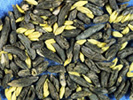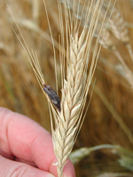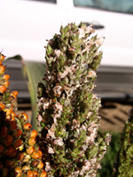David G. Schmale III
Virginia Polytechnic Institute and State University, Blacksburg, VA
Gary P. Munkvold
Iowa State University, Ames, IA
ERGOT ALKALOIDS
 |
|
Figure 5 |
 |
|
Figure 6 |
 |
|
Figure 7 |
 |
|
Figure 8 |
The ergot alkaloids are mycotoxins produced by several species of fungi in the genus Claviceps. The name ergot means 'spur' in French, since grains colonized with Claviceps spp. often resemble the spurs on the legs of a rooster [Figure 5]. There are four main groups of ergot alkaloids: the clavines, the lysergic acids, the lysergic acid amides, and the ergopeptides.
Ergot poisoning in humans and domestic animals is known as ergotism. This disease may cause strange hallucinations, the feeling of itchy and burning skin, gangrene, loss of hands and feet, and even death. Ergotism is one of the oldest known human diseases caused by mycotoxins. In the Middle Ages, humans suffering from a disease called St. Anthony's fire reportedly experienced symptoms that suggested ergot poisoning such as burning skin, insects crawling under their skin, and the loss of hands and feet [Figure 6]. In the 1690s, ergot alkaloids may have been the cause of symptoms associated with witchraft surrounding the Salem Witch Trials in Salem, Massachusetts. Ergotamine is one of the building blocks of the psychoactive drug lysergic acid diethylamide (LSD). Today, ergot alkaloids are being exploited for medicinal purposes including the treatment of migraines, the induction of child birth, and the control of post-partum bleeding.
Many different grasses may become contaminated with ergot alkaloids. Claviceps purpurea may infect the reproductive structures of cereal plants during cool, wet weather, with rye being the main economic host. Specialized fungal structures known as sclerotia (the ergots) develop from these reproductive structures and may be harvested with the grain [Figure 7]. If the sclerotia are processed into flour, high levels of contamination with ergot alkaloids may result. Claviceps africana and C. sorghi may contaminate sorghum with ergot alkaloids worldwide [Figure 8], but the relative toxicity of mycotoxins produced by these fungi has not been evaluated in detail. Common pasture grasses may be contaminated with alkaloids similar to those produced by ergot fungi, but these fungi belong to different genera and do not produce sclerotia. Click here for a plant disease lesson on ergot.
Next: Fumonisins
